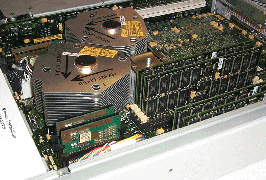 |
Click for Adager Sponsor Message |
| May
2001
A-Class aims to improve e3000 ownership costs Entry-level line drives support as low as system’s physical profile Eyes turned in amazement this spring as HP’s e3000 Platform Planning Manager Dave Snow toted a new A-Class e3000 just 3.5 inches high under his arm at the Solutions Symposium. But there’s something even lighter about the new entry-level systems: costs to maintain one. At the same time, HP is keeping down clock speed for the computers, apparently to give its N-Class low-end systems some definite advantages. The A-Class systems cost thousands less per year to support than the Series 9x8 and 9x7 computers they’re destined to replace. HP told its resellers that A-Class support runs $415 - $621 monthly for systems which can run up to 65-percent faster than the older low-end models. In contrast, Series 9x8 monthly support runs $418 - $1,431. The support cost difference is even greater for owners of Series 9x7 systems, the market HP is wooing hard to adopt the A-Class. Even a Series 917 owner can realize at least a $2,100 yearly savings on support when buying an A400 e3000. Based on figures HP shared with its resellers, customers at the top of the 9x7 line could net a savings of almost $38,000 a year — if their 987/200 had an unlimited MPE license. HP has been telling such 9x7 customers they can fund their A-Class purchase with the savings on support — a statement that might be more accurate for midrange and higher 9x7 owners over a few years of A-Class ownership. HP has made the claim more likely by raising support prices on all 9x7 support contracts signed after the A-Class was introduced. Not all support contract pricing has decreased for the newest entry-level systems. In comparing support for a three-year contract for a 918RX to an A400-100-110, the newer system comes in at more than $1,400 extra per year. This is a one-third increase in the base support cost for the new lowest-end e3000. “The support costs are where it’s going to be hard to make a good case to some of our customers,” said one reseller. “I suppose I should try telling them to expect sizable increases in their monthly support costs for their existing 918 and 928 servers. That brings it just about even, cost-wise. “While it’s nice that the lowest-end system horsepower went up by 65 — the 918LX was introduced seven years ago — the year-to-year cost in support just jumped by 33 percent.” Processor turndown If some support advantages are clear for the A-Class, so are its speed limitations. The computer is an entry-level choice by definition — but HP has ensured the A-Class won’t compete with the low-end models of its N-Class e3000 line.
Comparisons to HP 9000 servers which use the same hardware have not been favorable. While HP won’t confirm the method, e3000 A-Class models are using some way of reducing the speed of the same processors which run faster in HP 9000 units. A look at the speed lineup of the 3000 line shows little room between the two-processor A-Class systems and the bottom on the N-Class e3000 line. An A500 with two CPUs is rated at 42 on the study created by AICS Research, makers of the QueryCalc software for the 3000 and a vendor with more than 20 years in the market. AICS clocks the slowest N-Class at a 69, and the slowest A-Class comes in at a 17, while the 918 and 917 systems rate a 10. Some customers and Special Interest Group (SIG) leaders see the price/performance numbers of the e3000 A-Class as more than 10 times slower than those of HP 9000 A-Class systems. Ken Sletten, chair of SIG-IMAGE/SQL, notes that the HP 3000 A-Class hardware costs three times what its 9000 counterpart costs, and performs three or more times slower in clock speed (140 MHz versus 440 for the HP 9000 model). The comparisons don’t match up when considering IMAGE applications, since there’s no way to get a benchmark of IMAGE on the HP-UX systems. But for any applications staying outside IMAGE, like those written in Java and calling external databases, the e3000 A-Class deficit looms large. “I realize raw CPU performance is not the whole story,” Sletten said, “but it’s a big part of the story. “Especially for CPU-hungry Internet apps like Java, Apache and Enhydra, that 12:1 ratio is prohibitive,” Sletten said in posing a question for this summer’s HP World Interex e3000 Roundtable. “When will HP come out with an ‘un-crippled’ e3000 A-Class? It is the performance disadvantage and not the price disparity that is the main problem: At this level, initial purchase is a small part of five-year cost of ownership. But the performance disadvantage you pay for every day.” Some see the clocked-down A-Class servers as hampering Java’s potential for the 3000. The language offers fresh prospects for new applications on the platform. It’s been a long time since a new application using IMAGE has emerged for the 3000. But SIG-Java co-chair Gavin Scott says this first round of e3000 A-Class servers does Java no favors. “MPE may be good, but is it 12 times better than HP-UX?” Scott asked on the Internet. “If your Web server and Java/Enhydra applications will run faster on HP-UX at one-third the cost [of the hardware], why in the world would you not immediately move them off of MPE?” Product Planning manager Snow of HP said the A-Class will get faster in future releases, but it will require releasing faster N-Class systems. “As we raise the frequency at the high end, we’ll raise the frequency at the low end,” Snow said.
|
Copyright The 3000 NewsWire. All rights reserved.

